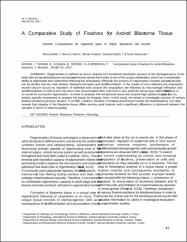| dc.contributor.author | Keskin, İlknur | |
| dc.contributor.author | Yıldırım, Berna | |
| dc.contributor.author | Kolbaşı, Bircan | |
| dc.contributor.author | Öztürk, Gürkan | |
| dc.contributor.author | Demircan, Turan | |
| dc.date.accessioned | 10.07.201910:49:13 | |
| dc.date.accessioned | 2019-07-10T19:56:43Z | |
| dc.date.available | 10.07.201910:49:13 | |
| dc.date.available | 2019-07-10T19:56:43Z | |
| dc.date.issued | 2017 | en_US |
| dc.identifier.citation | Keskin, İ., Yıldırım, B., Kolbaşı, B., Öztürk, G. ve Demircan, T. (2017). A comparative study of fixatives for axolotl blastema tissue. International Journal of Morphology, 35(1), 47-51. https://dx.doi.org/10.4067/S0717-95022017000100009 | en_US |
| dc.identifier.issn | 0717-9502 | |
| dc.identifier.issn | 0717-9367 | |
| dc.identifier.uri | https://dx.doi.org/10.4067/S0717-95022017000100009 | |
| dc.identifier.uri | https://hdl.handle.net/20.500.12511/2796 | |
| dc.description | WOS: 000400464600009 | en_US |
| dc.description.abstract | Regeneration is defined as tissue renewal and functional restoration process of the damaged parts of the body after an injury. Ambystoma mexicanum, commonly named the Axolotl, is one of the unique vertebrates, which has a remarkable ability to regenerate their extremities following the amputation. Although the process of regeneration includes several periods, it can be divided into two main phases; blastema formation and dedifferentiation. In the couple of hours following the amputation, wound closure occurs by migration of epithelial cells around the amputation site followed by macrophage infiltration and dedifferentiation of cells to turn into stem cells. Accumulated stem cells form a very authentic tissue type called blastema, which is crucial for successful regeneration. In order to evaluate this exceptional tissue and acquire high quality images, it is crucial to employ specific procedures to prepare the tissue for imaging. Here, in this study, we aimed to investigate success of various fixative solutions (Carnoy's, Bouin's, % 10 NBF, Clarke's, Alcoholic Formaline and AFA) to monitor the fixed blastema. Our data reveals that integrity of the blastema tissue differs among used fixatives and a significant difference is observed between the samples in terms of staining quality. | en_US |
| dc.description.abstract | RESUMEN: La regeneración se define como la renovación del tejido y el proceso de restauración funcional de las partes dañadas del cuerpo después de una lesión. Ambystoma mexicanum, comúnmente llamado Axolotl, es uno de los únicos vertebrados que tiene una notable capacidad para regenerar sus miembros después de una amputación. Aunque el proceso de regeneración incluye varios períodos, se puede dividir en dos fases principales: formación del blastema y desdiferenciación. En el par de horas después de la amputación, el cierre de la herida ocurre por la migración de células epiteliales alrededor del sitio de la amputación seguido por una infiltración de macrófagos y la desdiferenciación de las células para convertirse en células madre. Las células madre acumuladas forman un tipo de tejido muy diferenciado denominado blastema, que es crucial para una exitosa regeneración. Para evaluar este tejido y adquirir imágenes de alta calidad, es crucial emplear procedimientos específicos para la obtención de imágenes. En este estudio, se intentó investigar el éxito de varias soluciones fijadoras (Carnoy, Bouin, % 10 NBF, Clarke, Formalina Alcohólica y AFA) para monitorear la fijación del blastema. Nuestros datos revelan que la integridad del tejido del blastema difiere entre los fijadores utilizados y una diferencia significativa observada entre las muestras se da en términos de la calidad de tinción. | en_US |
| dc.language.iso | eng | en_US |
| dc.publisher | Soc Chilena Anatomia | en_US |
| dc.rights | info:eu-repo/semantics/openAccess | en_US |
| dc.subject | Axolotl | en_US |
| dc.subject | Blastema | en_US |
| dc.subject | Fixatives | en_US |
| dc.subject | Histology | en_US |
| dc.subject | Axolotl | en_US |
| dc.subject | Blastema | en_US |
| dc.subject | Fijadores | en_US |
| dc.subject | Histología | en_US |
| dc.title | A comparative study of fixatives for axolotl blastema tissue | en_US |
| dc.title.alternative | Estudio comparativo de fijadores para el tejido blastema del axolotl | en_US |
| dc.type | article | en_US |
| dc.relation.ispartof | International Journal of Morphology | en_US |
| dc.department | İstanbul Medipol Üniversitesi, Tıp Fakültesi, Temel Tıp Bilimleri Bölümü, Histoloji ve Embriyoloji Ana Bilim Dalı | en_US |
| dc.department | İstanbul Medipol Üniversitesi, Uluslararası Tıp Fakültesi, Temel Tıp Bilimleri Bölümü, Fizyoloji Ana Bilim Dalı | en_US |
| dc.department | İstanbul Medipol Üniversitesi, Uluslararası Tıp Fakültesi, Temel Tıp Bilimleri Bölümü, Tıbbi Biyoloji Ana Bilim Dalı | en_US |
| dc.department | İstanbul Medipol Üniversitesi, Rektörlük, Rejeneratif ve Restoratif Tıp Araştırmaları Merkezi (REMER) | en_US |
| dc.authorid | 0000-0002-7059-1884 | en_US |
| dc.authorid | 0000-0001-7933-4262 | en_US |
| dc.authorid | 0000-0003-0352-1947 | en_US |
| dc.identifier.volume | 35 | en_US |
| dc.identifier.issue | 1 | en_US |
| dc.identifier.startpage | 47 | en_US |
| dc.identifier.endpage | 51 | en_US |
| dc.relation.publicationcategory | Makale - Uluslararası Hakemli Dergi - Kurum Öğretim Elemanı | en_US |
| dc.identifier.doi | 10.4067/S0717-95022017000100009 | en_US |
| dc.identifier.wosquality | Q4 | en_US |
| dc.identifier.scopusquality | Q3 | en_US |


















